|
Volunteers, your continued commitment to conservation is inspiring! In this edition, we celebrate all that you do, from the enjoyment of volunteering after a successful career to the many species and habitat accomplishments that keep you engaged and active in conservation. You are the heart of our efforts!
We also recognize that many of our volunteers might have been impacted by Hurricane Ian. Know that our FWC officers are working tirelessly to perform search-and-rescue, welfare checks, reconnaissance, and public safety missions for those impacted by Hurricane Ian. If you are in need of food, water or basic supplies, visit a Point of Distribution near you: floridadisaster.org/info/.
For those who are available to volunteer and assist with Hurricane Ian Relief Efforts, connect with Volunteer Florida at https://Volunteer.volunteerflorida.org/search. We will also share Hurricane Ian conservation-related volunteer opportunities on our Facebook page (@FWCVolunteers) as they come available.
Warmest wishes to our volunteer family as we move into the fall season!
— the FWC's Volunteer Program Team
Welcome!
Welcome Rhett Barker to the FWC’s Volunteer Program Team! He is joining the agency as the new Volunteer Program Biologist for the FWC’s Northwest Region.
Rhett received his Bachelor of Science in Wildlife Ecology and Conservation from the University of Florida and his Master of Fine Arts in Science and Natural History Filmmaking from Montana State University. His thesis film was a 360-video documentary about the Santa Fe River. Rhett grew up in Live Oak and spends most of his time exploring this state’s springs and rivers. He is excited to work with the public to help protect Florida’s natural resources! When he isn’t working, Rhett is usually out exploring the great outdoors.
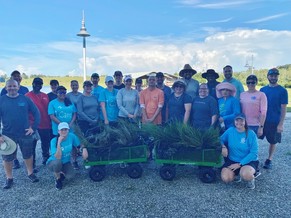 On Friday, August 26, the Suncoast Youth Conservation Center hosted a volunteer day focused on harvesting marsh grasses. The team of volunteers worked together to collect 500 Spartina patens plants and 500 Spartina alterniflora plants. The grasses were pulled from an area where they were beginning to overgrow and given to a local partner who transplanted them into another wetland. These plants are beneficial for erosion control, water filtration, and providing habitat in and around the water. Together, the two species of grass will help restore the site at which they were replanted. Along with the 22 volunteers and three staff who participated in this 2-hour volunteer event was a surprise guest – a wild dolphin swam through the on-site Newman Branch Creek while everyone was out pulling the grasses and put on quite a show catching fish in the water!
By Amy Compare
The FWC’s Northeast (NE) Region completed a successful season of avian volunteer projects, including Southeastern American Kestrel nest box monitoring, Florida Scrub-Jay monitoring through Florida Audubon’s Jay Watch program, and Eastern Bluebird nest box monitoring!
Southeastern American Kestrel Monitoring
This season in the NE Region, seven FWC volunteers and a handful of Marion County Audubon volunteers helped monitor Southeastern American Kestrel nest boxes in Marion, Levy, Sumter and Citrus counties.
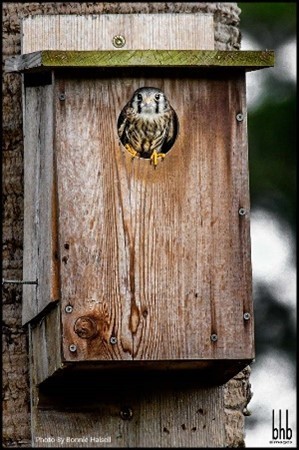 A Southeastern American Kestrel peeked out from a kestrel nest box at the Ocala Recharge Park. Photo by Bonnie Halsell.
For the past several years, the boxes along Marion County roadways have been monitored by Jason and Preston Ballard. They have continued to show exemplary leadership and commitment to their monitoring this year. Preston recently graduated from high school and moved to Tallahassee to start his academic career at Florida State University. We are grateful for the time Jason and Preston have spent monitoring kestrel boxes over the years. As they move on, new volunteers are joining the monitoring program. This July, Bailey McClellan, Nick McClellan and Anna Pettypool came out for the last monitoring day of the season. We hope to see them back next season!
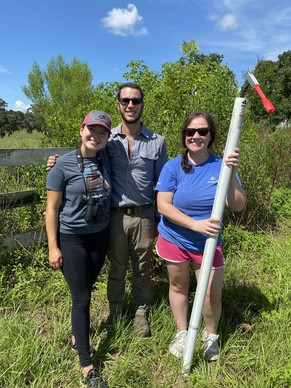 Volunteers (left to right), Bailey McClellan, Nick McClellan and Anna Pettypool monitored kestrel boxes along Marion County roadways this July.
Kestrel boxes along Levy County roadways had been monitored in the past but had been neglected for a few years. This season, we had some dedicated volunteers help monitor boxes again. Cindy Leppala helped monitor for the first half of the season and April Russell jumped in for the second half. Just as in Marion County, volunteers monitoring kestrels provided critical data that FWC biologists used to determine the timing of chicks hatching to be able to band them at an ideal age.
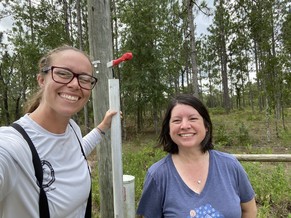 Volunteer Program Biologist Amy Compare (left) and April Russell (right) monitored kestrel boxes in Levy County.
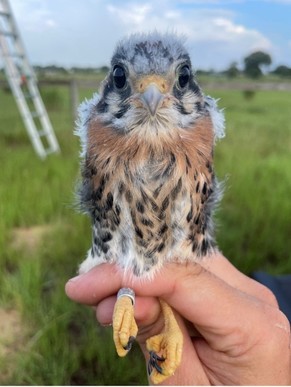 Juvenile kestrel banded at the correct age in Levy County thanks to data collected from volunteers.
The FWC has continued into year two of a partnership with Marion Audubon and Ocala City Parks with monitoring kestrel boxes that have been placed in Ocala City Parks. Thank you to all the Marion County Audubon volunteers who monitored the boxes this season for FWC biologists and a huge thank you to Josie Muncy who organized Audubon volunteers and to Tami Reece who led box monitoring this summer.
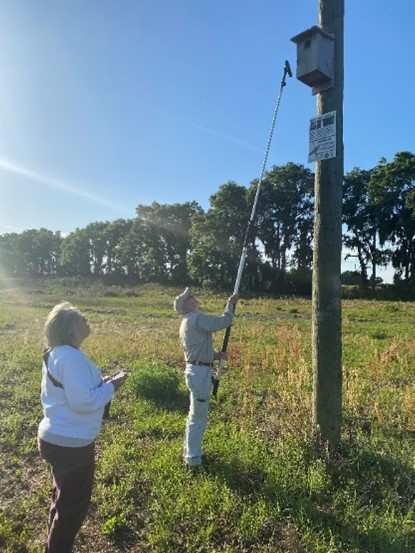 Left to right, Linda Howell and Josie Muncy monitored a kestrel nest box at the Ocala Sportsplex during a volunteer training day.
As they have been doing for years, Brinda Curran and Virginia Hall have been monitoring kestrel boxes at Potts Preserve WMA and Panasoffkee WMA. Thank you, Brinda and Virginia, for another great season!
Jay Watch 2022
This summer, FWC volunteers helped with Jay Watch, Florida Audubon’s annual statewide Florida Scrub-Jay survey. In Marion County, FWC volunteers helped with surveys at the Cross Florida Greenway Triangle, Potts Preserve WMA, Halpata Preserve, and Ross Prairie State Forest. Thank you to Brinda Curran, Virginia Hall, Scott LaRosa and Carey LaRosa for leading survey teams this year! And thank you to Tami Reece, Cherryl Marlan, Cheryl Varona, Victoria Hawk, Ashley Dolan, Kim Rexroat, Louise Roy, Kent Weakly, and Mason Sylvester for participating in surveys this year! Your commitment and enthusiasm helped everything go smoothly.
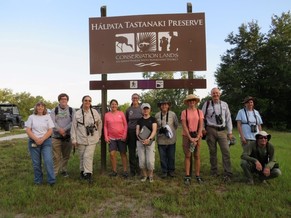 Volunteers surveyed for Scrub-Jays at Halpata Tastanaki Preserve. Photo by Jacqui Sulek.
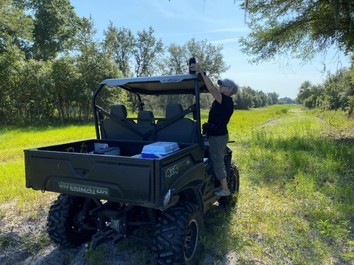 Brinda Curran turned on a Scrub-Jay call recording, following the Audubon Jay Watch survey protocol.
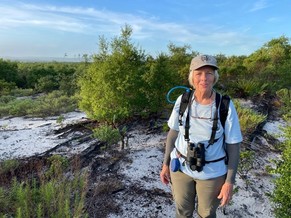 Lois Posey spent eight days helping to survey in Ocala National Forest.
Brinda and Virginia also helped Greenway Triangle Land Manager Laurie Dolan with the banding of juvenile jays. They have participated in this for the past several years and banding would not be nearly as successful without their help.
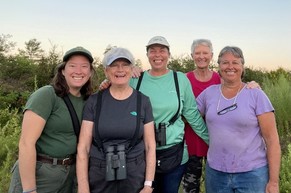 Left to right, Jennifer Klindt (Florida Forest Service Biologist), Brinda Curran (FWC Volunteer), Laurie Dolan (Greenway Triangle Land Manager), Virginia Hall (FWC Volunteer), and Monica Folk (Wild Folk, bird bander) banded juvenile Scrub-Jays at the Greenway Triangle this August! Photo by Brinda Curran.
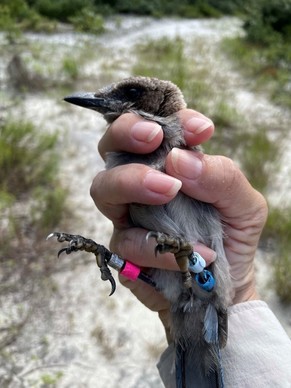 A juvenile Scrub-Jay after being banded at the Greenway Triangle. Photo by Brinda Curran.
Bluebird Nest Box Monitoring
Volunteers Carey and Scott LaRosa spent about 4 hours every other week leading monitoring of bluebird boxes in Ross Prairie State Forest from February through August. Their dedication and commitment to monitoring was a huge help to FWC biologists!
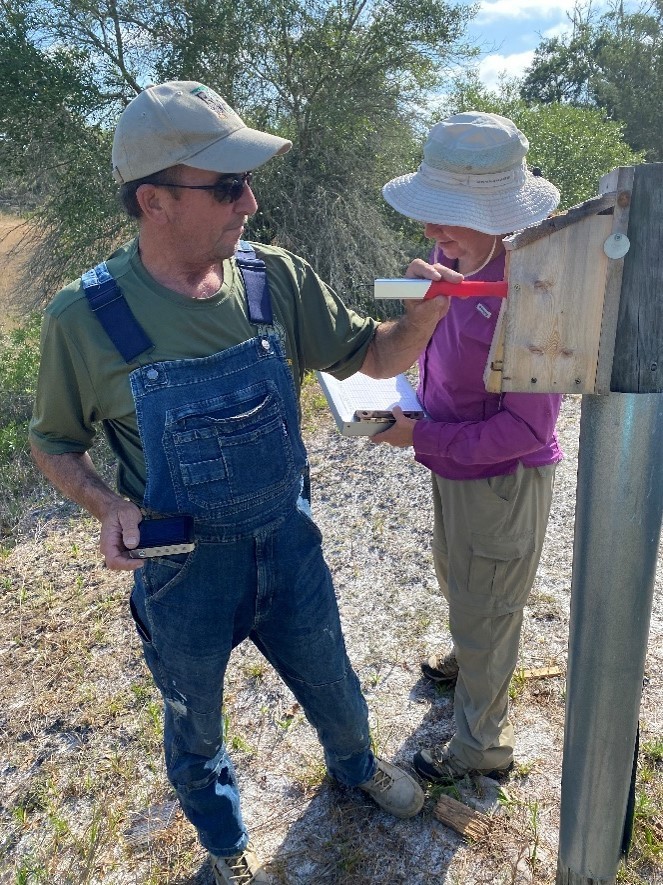 Scott and Carey LaRosa monitored bluebird boxes.
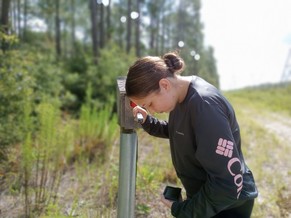 Macaela Irwin monitored bluebird boxes in Ross Prairie State Forest. Photo by Carey LaRosa.
If you are interested in participating in any of these projects for next season, please reach out to volunteer@myfwc.com and specify which projects you would like to join and where you are located.
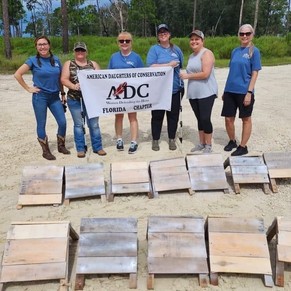 American Daughters of Conservation members stand in front of chick shelters they built.
Thank you to the American Daughters of Conservation who came to the Chinsegut Conservation Center to build shorebird chick shelters! Chick shelters are set up on beaches and are used to provide cover for flightless shorebird chicks from predators and protection from extreme temperatures. Seven volunteers from American Daughters of Conservation, including Stacy Whittum, Jessica L. Carter, Brittnie Curley, Gayle Deshong, Jeanene Arrington Fisher and Beth Qualey spent about 11 hours constructing these shelters!
In addition to your generously donated time and talent, we welcome tax-deductible monetary contributions to the FWC's Volunteer Programs. Visit the Fish & Wildlife Foundation of Florida to make a donation. Your support will help us expand volunteer opportunities as we work to foster a statewide network of conservation volunteers. Thank you for supporting Florida's fish and wildlife resources!
|